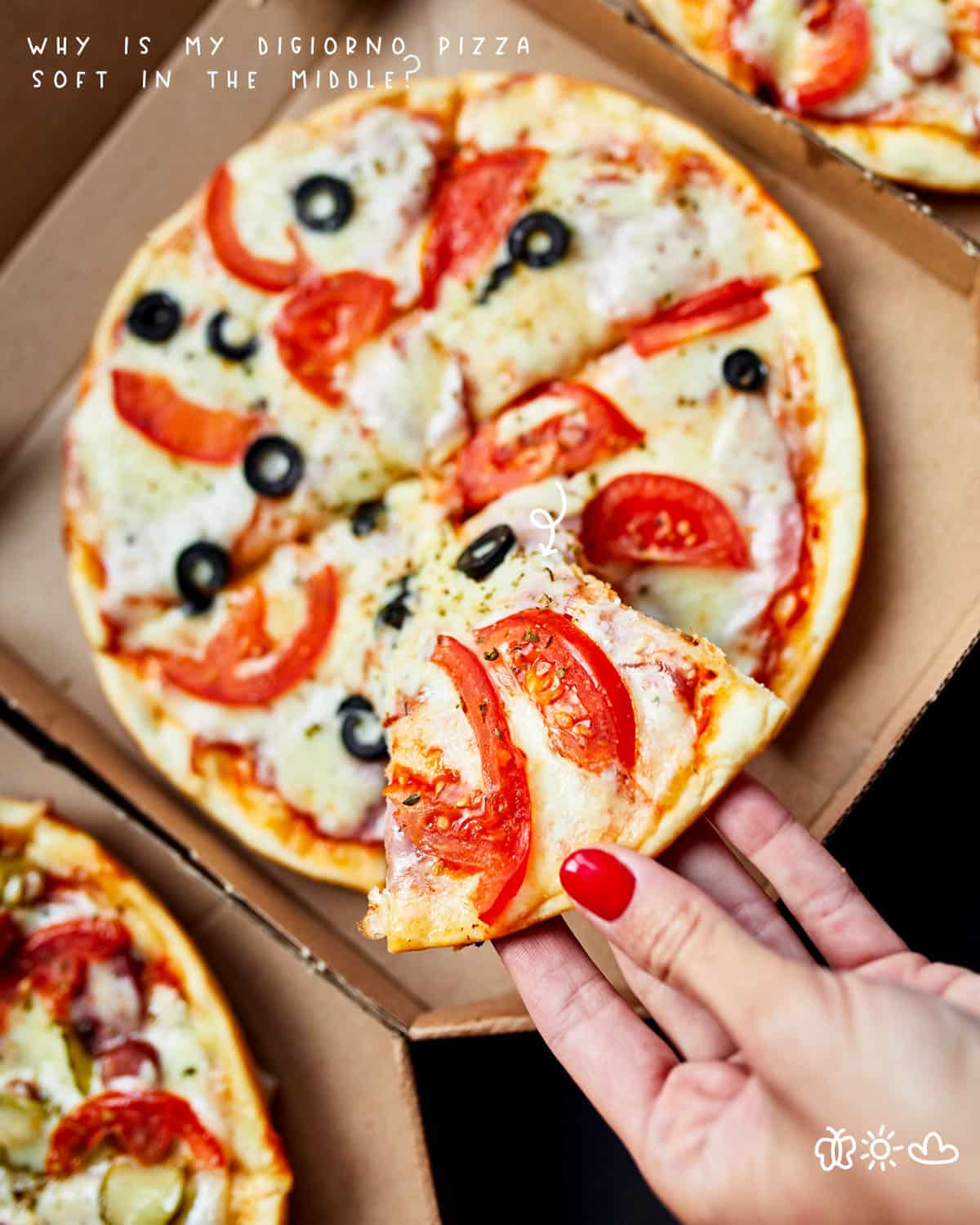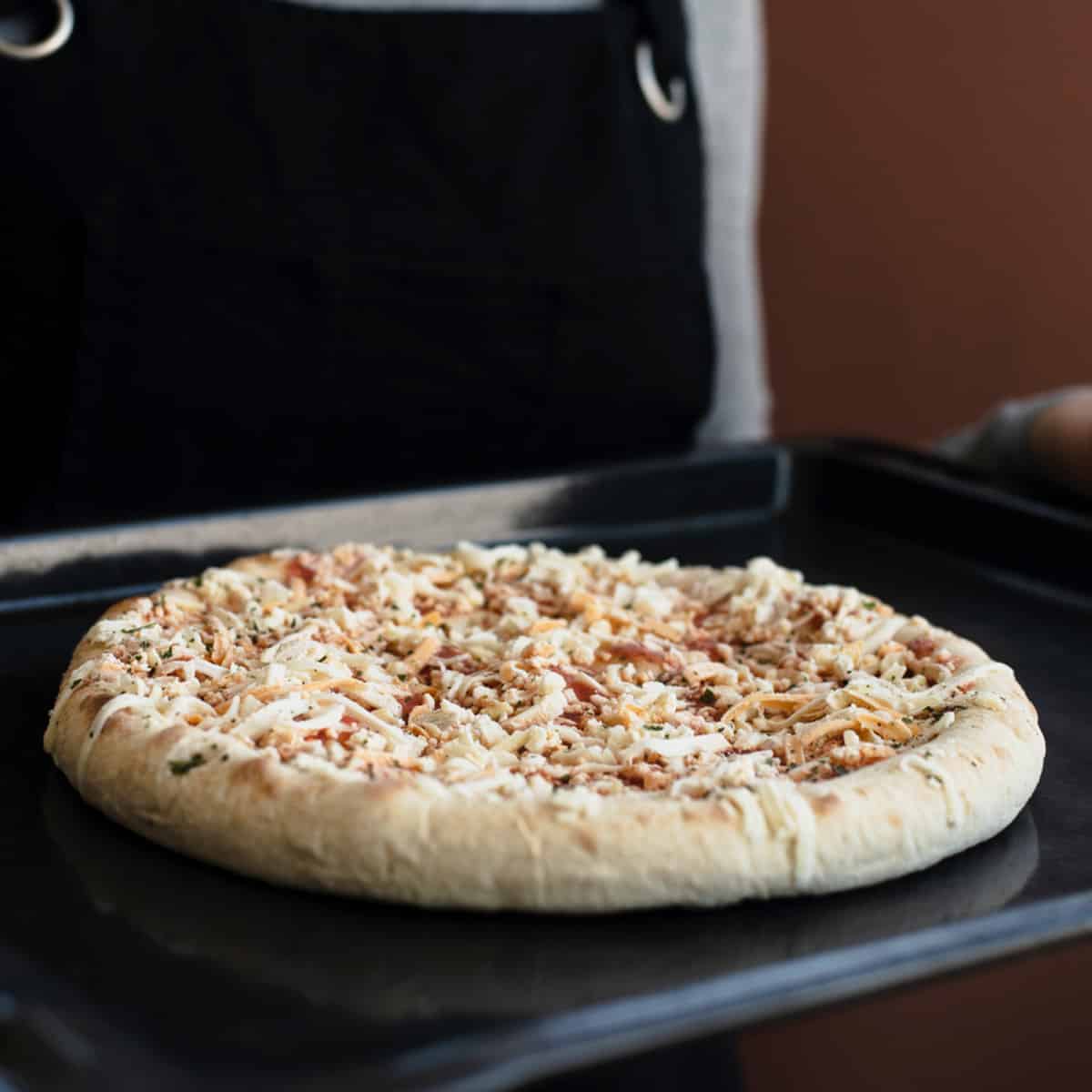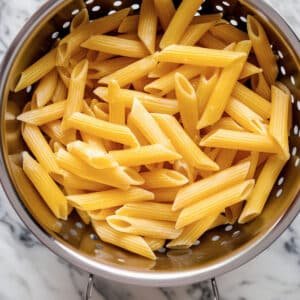If you've ever ordered a DiGiorno pizza, you know that the crust is always nice and crispy. But what happens when you get to the middle of the pizza? You guessed it - it's soft and doughy. So what's going on here? Why can't DiGiorno get their pizzas to cook evenly? It turns out, there's a science behind why your DiGiorno pizza is soft in the middle. And today, we're going to explain it all to you. Keep reading to learn more!

What is DiGiorno pizza?
In grocery stores, DiGiorno pizza is available as a frozen food product. The company that manufactures DiGiorno pizza is Nestle. Frozen pizza is a popular food product because it is convenient and easy to prepare, and DiGiorno pizza is one of the most popular frozen pizza brands.
DiGiorno has been delivering delicious, oven-fresh pizzas to families for over 25 years as the originators of frozen pizza. Made with only the best ingredients, its Classic Thin Crusts are crispy and thin - perfect for a quick and easy meal that the whole family can enjoy.
Its original rising crust pizza is still as good as ever and has that freshly baked taste that everyone loves.
In addition to their popularity, DiGiorno pizzas have a few other reasons to appeal to their customers.
- First, the company uses high-quality ingredients and follows a strict process to ensure that its pizzas are consistently delicious.
- Second, the pizzas are quick and easy to cook, so they're perfect for busy weeknights.
- And lastly, they're affordable, so you can enjoy a gourmet pizza without breaking the bank.
DiGiorno offers many types of pizza, but they all have one thing in common: they are supposed to be crispy and delicious. So, why is my DiGiorno pizza soft in the middle?
Before we answer the question, let's examine DiGiorno's pizza-making process.
Read:
How are DiGiorno pizzas made?
First, the company uses a high-protein flour milled especially for DiGiorno and then slow-fermented to develop the gluten network. Crisp and chewy crust result from this process. Its signature red sauce comes from California-grown tomatoes, and the whole pizza is flash-frozen to preserve freshness.
Most commercial pizzerias freeze their dough to make it easier to handle and store, but freezing can damage the gluten and make the crust tough. DiGiorno shuns the common practice of freezing the dough before baking. Instead, DiGiorno bakes its Dough fresh daily and then quickly freezes the pies.
What is flash-freezing in pizza mean?
Flash freezing is a process where the pizza dough is frozen very quickly. It is a type of blast chiller that freezes the pizza dough in a matter of seconds. This type of freezing preserves the freshness and flavor of the pizza. It also doesn't damage the gluten like traditional freezing methods, so you end up with a crust that's still delicious and chewy.
How does this affect my DiGiorno pizza?
So why does this affect your DiGiorno pizza? Because the dough is frozen quickly, it doesn't have time to form large ice crystals. In other words, when you bake the pizza, the dough will retain its original shape and won't be tough or chewy. As a result, the sauce will have a stronger flavor since the dough does not dilute it.
As for the sauce, DiGiorno uses a special blend of spices to give it a unique flavor that's different from other brands. The company also operates a longer cooking process to reduce the acidity of the tomatoes and bring out their sweetness.
The company also uses a higher proportion of cheese than most other brands, which results in a gooier, cheesier pizza. The cheese is a blend of mozzarella, cheddar, and Parmesan.
Are DiGiorno pizzas precooked?
No, DiGiorno pizzas are not precooked. They are designed to be cooked in a conventional oven at 400 degrees Fahrenheit for about 20 minutes. Depending on your oven, the baking time may vary slightly, so keep an eye on the pizza. Due to DiGiorno pizza's variety of crusts, cheeses, and sauces, the middle of your pizza might be different in doneness than the edge. You can check their website for the cooking instructions for your specific pizza.
Why is DiGiorno pizza so good?

Because of the quality of the ingredients and the care taken in manufacturing the pizza, DiGiorno pizza tastes good. A crispy, chewy crust and a sweet, flavorful sauce result from the high-protein flour, slow fermentation process, and fresh ingredients.
The company's flash-freezing process also ensures that the pizzas maintain their freshness and flavor. It's no wonder that DiGiorno is one of the most popular frozen pizza brands in America.
DiGiorno pizza hits the spot when you're craving a delicious, cheesy pizza but don't want to deal with the hassle of making one from scratch. It's doughy and chewy, with just the right amount of sauce and cheese. Plus, it's quick and easy to cook so you can have a hot, delicious pizza in no time.
Whether you're having a night in with friends or family or looking for an easy meal to feed a crowd, DiGiorno pizza is always a good choice.
Different Types Of Digiorno Pizza
While DiGiorno pizzas all use a pre-made crust, they actually offer several different kinds of pizza. There's the original thin and crispy crust and a deep dish option. There are also several different types of cheese that you can choose from, including mozzarella, cheddar, and pepperoni.
Why is my DiGiorno pizza soft in the middle?
When frozen pizza first came out, it was a game-changer. You no longer had to wait for the pizza guy to show up or worry about the pizza getting cold on the way home from work. You could just pop it in the oven and have a hot, fresh pizza in minutes.
But as anyone who has ever had a frozen pizza knows, they're not always perfect. One of the most common complaints about frozen pizza is that the center is often doughy and soft, while the crust is nice and crispy.
So what's the deal? Why is this such a common problem with frozen pizza? Is there any way to prevent it from happening?
A closer look at the causes of DiGiorno frozen pizza being soft inside will give us a better understanding of the problem. And how you can avoid this common issue when cooking your next pizza.
1 Frozen pizza:
The preparation of the pizza causes a frozen pizza to become soft after cooking. Similarly, it will become soggy if you don't cook the pizza correctly. Pizzas made with frozen dough tend to be soft and fluffy because there is a lot of water in the dough.

How does it happen?
When you put a frozen pizza in the oven, the heat starts to cook outside the crust first. The water in the dough starts to cook faster than the flour, and this causes the gluten strands to break down, leaving you with a softer, doughier middle.
The cheese and sauce begin to melt, and the toppings get hot. However, because all that frozen goodness is in the middle of the dough, it takes longer to cook.
Most often, the dough's crust is already too brown by the time the inside is cooked, resulting in a crisp crust but a soft interior.
How to avoid this:
One way to avoid this issue is to let the pizza thaw for 30-60 minutes before cooking. This will allow the dough to rise slightly and will give it a chance to cook more evenly. You can also try cooking the pizza at a lower temperature for a more extended period. While the outside is cooking, the inside is catching up. This will prevent the outside from overcooking.
2 Not preheating the oven:
The fourth reason your frozen pizza might come out doughy is that you didn't preheat the oven properly. When you put a frozen pizza in the oven, it's important to preheat the oven to the correct temperature before cooking. This will help the pizza cook evenly all the way through.
How does it work?
Preheating the oven allows the pizza to cook evenly from the start because the oven is already at the correct temperature. Without preheating the oven, the pizza will start to cook unevenly, and the dough will often be doughy in the middle.
3 Not cooking the pizza long enough:
The ease of cooking a store-bought pizza means that sometimes people don't cook them long enough. No matter how well the dough was frozen, it still needed time to cook evenly. If you don't cook it long enough, the center will be doughy while the crust is crispy. People are often impatient and want to eat their pizza as soon as it comes out of the oven.
So you need to cook the frozen pizza longer? Depending on the pizza, the cooking time can range from 15 to 22 minutes. The best method would be to cook the dough until the edges are brown to ensure thoroughly cooked dough.
4 You didn't completely thaw the dough
One of the most common reasons for a doughy, soft pizza is that the dough isn't thawed completely. When you're in a hurry, it can be tempting to just put the pizza straight into the oven without waiting for the dough to unfreeze.
But this is a mistake! The dough must thaw thoroughly before cooking. If you don't give the dough enough time to defrost, the center will be doughy and soft while the edges are crispy.
To avoid this, make sure to thaw the pizza dough completely before cooking. You can do this by letting it sit at room temperature for about an hour or overnight in the refrigerator.
To cook a pizza, it must reach room temperature or be close to it. The temperature of the pizza when it goes into the oven is critical because it helps to prevent the dough from being doughy in the middle. Cooking the dough this way will ensure even cooking.
How does it work?
When you thaw the pizza, it allows the dough to rise slowly and evenly. This prevents the outside from cooking too quickly and the inside from being doughy. Cooking frozen pizza slowly also allows the cheese to melt evenly. If you cook it too quickly, the cheese will be gooey and runny in some spots and hard and dry in others.
The instructions on the pizza box warn against thawing the pizza before cooking, but if you want to prevent a soft, doughy pizza, it's best to thaw it first.
Why thaw the pizza first?
Slow-cooking frozen pizza enables the cheese to melt evenly. It allows the dough to rise slowly and evenly. This prevents the outside from cooking too quickly and the inside from being doughy. If you cook it too quickly, the cheese will be gooey and runny in some spots and hard and dry in others.
5 Adding Extra Toppings:
When you add extra toppings, it can make the pizza doughy because it adds weight and moisture. Also, extra toppings can make it difficult for the heat to evenly cook the pizza. So if you want to avoid a doughy pizza, it's best to stick with the basic toppings.
6 Too much sauce:
Adding too much sauce or a watery sauce can make pizzas fall victim to this. The dough can become soggy when sauce seeps through it.
There are three ingredients in the dough: flour, water, and yeast. The yeast creates carbon dioxide gas, and the gas bubbles make the dough rise. These same gas bubbles also make the dough porous. Since the dough is porous, the sauce can seep in and make the dough wet.
Moreover, the sauce can also become more watery when it's frozen. That's because the tomatoes release their juices and the liquid content becomes ice. When it thaws, the sauce can be a little runnier than initially.
How to prevent a soft middle pizza with frozen pizza
Turns out, there's a science behind why your DiGiorno pizza is soft or soggy in the middle after cooking. The dough is frozen, meaning the water in it is also frozen. When you cook a frozen pizza, the water in the Dough thaws and turns to steam, this steam gets trapped under the crust, making it soft or soggy.
There are a few things you can do to prevent a soft middle pizza:
1 Use pizza stone or steel
One way to prevent DiGiorno pizza from getting soggy in the middle is to cook it on a preheated pizza stone or baking sheet. This will help conduct heat evenly and prevent the steam from getting trapped under the crust.
What is a pizza stone?
A pizza stone is made of a material such as ceramic, stone, or clay. It is round or square and usually about ¼-inch thick. It helps to evenly distribute heat and prevent sticking when baking pizza or bread.
Where to buy:
You can find a pizza stone at your local kitchen supply store or online.
Important:
The pizza stone needs to be heated at 500 degrees Fahrenheit (250 degrees Celsius) for 30 minutes to one hour before cooking the pizza. Preheating the pizza stone ensures it's hot enough to cook the pizza dough through. The pizza stone needs time to absorb the heat from the oven so that it can cook the pizza evenly.
The same principle holds for a baking sheet. If a pizza stone is unavailable, preheat the baking sheet in the oven before cooking the pizza. This will help to cook the pizza evenly and prevent the dough from getting soggy in the middle.
Note:
I know using a pizza stone and preheating it for 30 minutes to an hour defeats the purpose of using a frozen pizza, which is to have a quick and easy meal. But if you're looking for ways to prevent your DiGiorno pizza from getting soggy in the middle, using a pizza stone is the way to go.
2 Thaw your frozen pizza before cooking
If you don't have a pizza stone, you can thaw your frozen pizza before cooking. This will help the water in the dough to evaporate before it has a chance to turn to steam and make the crust soggy. To thaw your frozen pizza, place it on a baking sheet and let it sit at room temperature for 30 minutes to 1 hour.
Don't cook your pizza straight from the freezer. Let it thaw for about 30 minutes to an hour first, so that the water has a chance to evaporate before it turns to steam.
3 Use a fork to poke holes
Another way to prevent your DiGiorno pizza from getting soggy in the middle is to use a fork to poke holes in the dough before cooking. This will allow the steam to escape and prevent it from getting trapped under the crust.
It's essential to poke the holes before cooking, so the dough doesn't rise and seal the holes shut.
Why is that? The yeast in the dough will activate when it comes into contact with the warm air and start to produce carbon dioxide gas. This gas will make the dough rise and seal the holes shut.
4 Use a perforated pizza screen
A perforated pizza screen is a metal screen with small holes that allows the heat to reach the pizza directly and prevents the steam from getting trapped under the crust. It's placed on top of the pizza stone or baking sheet and heated along with it. It helps to evenly distribute the heat and prevents the dough from getting soggy.
You can find these pans at most kitchen stores or online. They're not very expensive, and they'll make a big difference in the quality of your pizza.
5 Bake at a lower temperature
Another way to prevent your DiGiorno pizza from getting soggy in the middle is to cook it at a lower temperature. This will give the dough more time to cook without burning the cheese or the toppings. The dough will be able to rise and cook evenly as well.
How does it work?
When you cook pizza at a lower temperature, it allows the dough to rise slowly and evenly. As a result, the outside won't get overly cooked, and the inside won't get too doughy.
It's also important to cook the frozen pizza at a low temperature so that the cheese has a chance to melt evenly. If you cook it too quickly, the cheese will be gooey and runny in some spots and hard and dry in others.
What temperature should you cook frozen pizza at?
A good rule of thumb is to cook it at about 25 degrees Fahrenheit lower than the package directions. So, if the package directions say to cook the pizza at 400 degrees Fahrenheit, you should cook it at 375 degrees Fahrenheit.
- If you're using a pizza stone or baking sheet, preheat the oven to 500° Fahrenheit and preheat the pizza stone or baking sheet for at least 30 minutes.
- If you're using a perforated pizza screen, preheat the oven to 425° Fahrenheit and place the screen on top of the pizza stone or baking sheet.
How long do you cook the frozen pizza?
When cooking a frozen pizza, cook until the crust is golden and the cheese is melted and bubbly. This usually takes about 15-20 minutes, depending on your oven. However, it's best to keep an eye on it and start checking it around the 12-minute mark.
Some people like to put a sheet of foil over the pizza for the first few minutes of cooking to prevent the cheese from burning. This is not necessary, but you can do it if you're worried about cheese burning.
The last few minutes of cooking are crucial. If you find that your pizza isn't cooked through, you can always turn up the oven to 400° or 425° Fahrenheit (200 to 225 degrees Celsius) for the last few minutes of cooking.
6 Avoid over-topping
One common mistake people make when cooking frozen pizza is over-topping it. This can cause the dough to be soggy and the cheese to run off.
Overtopping your pizza overwhelms the base, so heat cannot travel through it quickly to cook it. Because the moisture from the dough can't escape underneath this mound of toppings, there can be doughy patches.
7 Preheat the oven
Make sure to preheat your oven before cooking your pizza. By doing so, the pizza will cook evenly from start to finish. Preheating the oven helps to distribute the heat evenly and prevents the dough from getting soggy.
8 Cool your pizza on a rack
Sometimes, you can do everything right, and your pizza will still turn out soggy in the middle. If this happens, don't despair! There is still a way to save your pizza.
All you need to do is transfer your pizza to a cooling rack and let it cool for a few minutes. This will allow the air to circulate and prevent the bottom from getting soggy.
It makes perfect sense when you think about it. If the air can circulate around the pizza, it will help to dry out the bottom and prevent it from getting soggy. As pizza comes out of the oven it's full of steam. By cooling it on a rack, you allow that steam to escape and prevent the bottom from getting soggy.
Steam comes out from under the pizza and is trapped if you were to put it on a solid surface like a cutting board or plate.
9 Keep cheese to a minimum
Who doesn't love cheese? We sure do! But, when it comes to frozen pizza, less is more.
Adding too much cheese can cause the dough to be soggy and the cheese to run off. Aside from that, the weight of the cheese can cause the dough to collapse in the middle. While technically not soggy, the crust will be dense and doughy.
The best way to prevent this is to use less cheese than you think you need. It's essential to use a moderate amount of cheese so that it doesn't overwhelm the dough or cause the pizza to be soggy.
A good rule of thumb is to use about ½ cup of cheese for a 12-inch pizza.




